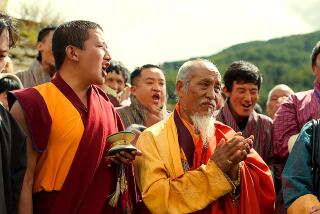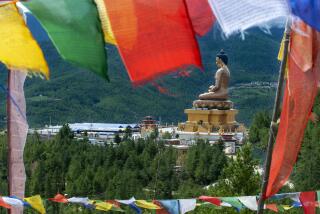Remote Kingdom Falls Prey to Remote Control
- Share via
THIMPHU, Bhutan — After sitting cross-legged around their wood-burning stove for a dinner of rice and butter tea, the Penjor family used to chat a bit and then go to bed early.
Nowadays they eat quickly, clean the dishes, then assemble in the living room, where they will spend the next three to four hours on the couch and floor, gazing at flickering images.
Shangri-La, meet the boob tube.
Bhutan, the Himalayan kingdom once so resistant to the outside world that it rarely let in a foreigner, got television two years ago. And not just a government-run channel of its own, but the whole gamut, uncensored--MTV, HBO, CNN, Indian movies, National Geographic, pro wrestling and, of course, commercial breaks.
Already television is changing speech patterns, topics of conversation, children’s behavior.
And with it come the laments all too familiar to parents everywhere.
“I come home after work and my wife and kids don’t look up from the TV to greet me,” says Tashi Phuntsog, secretary of the nation’s parliament and a father of five.
“Finally I pat the head of whichever child and they come over to me with their arms out, but their eyes are straight there on the TV.”
His 3-year-old daughter, he complains, has already picked up Indian songs off television, “but she can’t sing a Bhutanese song.”
Phuntsog feels the money spent on introducing television should have gone to schools, roads and electricity for the countryside. The government lifted the ban, he says, because it was tired of being criticized by foreign media for keeping out TV.
Squeezed between India and Chinese-ruled Tibet, Bhutan is about half the size of Indiana. It has mountains reaching to 22,000 feet and a population variously estimated at 600,000 to 2 million.
The country has had an ambivalent relationship with the world. It made English the medium of instruction in schools as far back as 1961, but only in 1974 were the international news media and the first paying tourists invited in for the coronation of King Jigme Singye Wangchuk.
On the throne since he was 16, the king and his four wives--all sisters, to cement a political clan alliance--have shepherded the poor but beautiful country gradually toward modernization.
Western-type hospitals are being built alongside traditional medicine clinics throughout the country. Kuensel, the weekly government-subsidized newspaper, is going private and has an Internet edition. One letter e-mailed by a U.S. reader offers tips on controlling children’s TV intake.
Among the brightly painted, wooden-roofed buildings of Thimphu, the 7,500-foot-high capital, high school girls with bobbed hair and backpacks gather at an Internet cafe, e-mailing pen pals who until recently had never heard of Bhutan.
In Wangdue, a village a half day’s drive from Thimphu, kids greet each other with shouts of “Aiwa!” picked up from commercials for the Japanese electronics company.
The capital of 50,000 people has developed to the point where its steep, winding streets endure a rush-hour traffic jam, and it’s hard to find parking space downtown in the evening as more people buy cars and eat out.
Yet drivers are so calm that four lanes of traffic stop to allow a stray dog to cross the road one afternoon.
“Gross national happiness is more important than gross national product,” the king likes to say, and even with television, some Western innovations are still kept at arm’s length.
A lone traffic light installed by the Indian company that built the road system was removed on grounds of ugliness and replaced by white-gloved traffic wardens who perform a hand-signal ballet in a gaily painted gazebo.
A brief flurry of mountain climbing ended when yak herders traveled to Thimphu complaining about foreigners walking on their sacred peaks.
The country is often called Shangri-La, the name of the Himalayan utopia invented by James Hilton in his classic 1933 novel “Lost Horizon.”
Bhutan calls itself Druk Yul, the Land of the Thunder Dragon. For all its laid-back, smiling ways, and the king’s cautious democratic reforms that include abolishing some of his own powers, the predominantly Buddhist country is tightly controlled.
In the name of national unity, everyone, regardless of ethnic heritage, must be able to speak Dzongkha, the national language. They must wear the traditional dress of the dominant Ngalong people at work, school or official functions. Only at home do they switch to jeans, jackets and T-shirts.
Bhutan’s human rights record sometimes comes in for criticism.
In 1990, the U.N. High Commissioner for Refugees says, 100,000 Nepali speakers were driven out of the Hindu south of Bhutan, and they are still in refugee camps in Nepal.
The Bhutan government replies that some officials were overzealous in evicting people they thought were illegal immigrants. It denies refugees’ accounts to the United Nations of soldiers raping and looting.
The government says freedom of religion is guaranteed, and it denies reports by the Vatican and the Southern Baptist Convention that the minuscule Christian minority is pressured to adopt Buddhism or emigrate, and that police interrogate pastors and record the names of churchgoers.
Buddhism is the national religion. Monks have a strong voice in the government and reserved seats in the National Assembly, selected through a nonvoting delegate system that starts at the village level.
Now, in a country where criticism of the king is treason and political prisoners are never mentioned, TV viewers suddenly can flip to foreign news programs and see Bhutanese exiles complaining about suppression of minorities and demanding democracy.
Satellite dishes had already been sprouting illegally in Bhutan in the 1990s, but TV’s official arrival in 1999 for the 25th anniversary of the king’s coronation was abrupt all the same.
The state broadcasting department had been given one year to import a French transmitter, buy cameras and monitors from India, train radio reporters to do TV and be ready in time for the anniversary. Simultaneously, satellite television and the Internet were allowed in.
On the government’s Bhutan Broadcasting System, a jazzy drumbeat with scenes of flag, king and country introduces a news program delivered in English and Dzongkha. Then comes a half-hour feature in English about the king’s recent town meetings, clean water or the postal system in the Maldive Islands.
And then, at the Penjor household of 15 people, plus the Bhindas, a family of five who have dropped in, it’s over to cable.
The Penjors got their TV a few weeks ago. They don’t all speak English, and they tend to misunderstand the foreign news. A story about a racy South African condom advertisement brings blank stares.
The family matriarch, 59-year-old Rinchen Wangmo, likes to make up her own comic story lines to items on the Bhutanese English-language news. But “Today’s program is not very good,” she decides. She’d like to see the National Geographic channel, but her grandchildren keep flicking the remote control, looking for cartoons until their heads droop sleepily into her lap.
Ugyen Penjor, a 25-year-old newspaperman, says the family watches too much television. His young relatives do homework for an hour, then stay up watching, sometimes until midnight. “When a Hindi movie comes on they watch it until the end.”
Chhimi Dorji, a 17-year-old at Motithang High School, laments that “people don’t go to religious festivals to get blessings. They stay at home and watch TV.”
“We are losing our customs and traditions because people see and copy the customs of other countries,” he says.
A classmate disagrees. “It’s a good opportunity for us to see his majesty, the king,” says Yangden, 18, who uses only one name. She likes cable sports programs but stopped watching Hindi movies “when I came to know it’s all unreal.”
With 85% of the people engaged in subsistence farming, Bhutan is one of the world’s poorest countries. Per capita income was $470 in 1995.
That’s the price of the Penjors’ simple Indian-made TV set, with a stabilizer to protect against electricity fluctuations. Cable costs $32 for installation, plus $4.30 a month.
There are only 5,000 TV sets receiving live broadcasts in Thimphu. Villages near the capital get videotapes of the programs that are driven over the mountains and played a day or two later in a hall or in the one house with a TV.
Television hasn’t yet reached the remote yak herders. They still have tales to tell of fighting off the Yeti-like migoi that attacks their cattle. Bhutan has a wildlife sanctuary to protect the mysterious creature. Outsiders have never seen it; the herders say it has the power to become invisible.
Bhutan’s national animal, however, can be seen. The takin, which looks like a mix of moose, goat and cow, lives in the Thimphu Zoo, reached by passing through two families’ backyards and evading their yapping dogs. The takin is the only creature in the zoo.
*
Bhutan government:
www.kingdomofbhutan.com
Kuensel newspaper:
www.kuensel.com.bt
More to Read
Sign up for Essential California
The most important California stories and recommendations in your inbox every morning.
You may occasionally receive promotional content from the Los Angeles Times.













